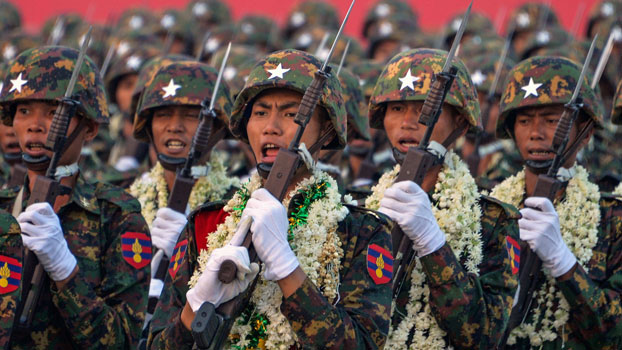The February military coup in Myanmar has now slowly but surely faded out of the headlines and public memory. Responses of international and regional institutions, in particular the UN and the ASEAN, have been at best tame, merely calling the junta to allow democracy to return and not in any way tell them to do so or else pay the price. Now even those who had been genuinely outraged, within and outside Myanmar, seem resigned not only to the reality of the coup, but also the possibility of another long spell of military rule in the country. Most countries are now inclined towards the pragmatic option of establishing ties with whoever emerges as the power wielders in the country, and not the moralistic one of aligning only with those fighting for return of democracy.
India’s emotional ties with Myanmar ought to have been much stronger considering the latter was part of British India till 1937, but as the late Ashok Mitra pointed out in a column A Dose of Heresy in a Kolkata daily a decade ago, India is by intuition not eastward looking. At the peak of the freedom struggle, when Myanmar (Burma then) was bifurcated from India, it went virtually unnoticed. Mitra hyperbolically even suggested that if along with Myanmar, the Northeast too had been thus separated then, the response could have been similar. That was then. Now things have changed, especially with China’s lengthening shadow in the region. While the dilemma on whether to treat the military coup in Myanmar as the country’s internal affair cannot be easy, on India’s part, at least it should come out with a refugee policy that takes cognizance of the presence of desperate political refugees from Myanmar on its territory. On a longer term perspective, it would also be prudent for the country to begin taking interest in what lies to its east, just as much as it does in developments in Pakistan and Afghanistan. Myanmar therefore is important.
In any consideration of Myanmar, what needs to be kept in mind is, without a complete structural and collective psychological overhaul, it does seem civil rule in Myanmar can never be complete. The fact that for most of the country’s postcolonial years since independence in 1948, it has been under military rule. The brief spell of partial democracy that returned a decade ago, has now again been smothered. The diagnosis will have to go beyond the popular explanation of power hunger of military leaders. It does seem there is also an underlying sense of a patriotic role of the military as guardians of the political establishment – an inherited DNA from the military’s roots as freedom fighting activists. Can an army with such a history come to be completely subordinate to civil authority? In a hypothetical scenario, if in 1947 it was the Indian National Army, INA, which liberated India, would the Indian Army with the INA’s genes in it, have been what it is today?
Commander of the Burma theatre during WWII, Field Marshal William Slim’s book Defeat Into Victory, has some interesting clues. Describing how he twice met General Aung San, father of Aung San Suu Kyi, and leader of Myanmar freedom struggle as well as founder of a militiamen army, Burma Defence Army and later Burma National Army, who wanted to negotiate terms for switching sides to the British after some years of fighting alongside the Japanese and the INA. This was in May 1945 and Slim had turned the table in this conflict theatre and the Japanese were on the retreat. Whether this was opportunism on Aung San’s part is another question. There were many on the British side who were sceptical, believing militarily BNA would have little to offer and that the group’s Burmese nationalism would be a headache for the British after the war. Allied Supreme Commander in the Pacific Theatre, Lord Mountbatten however favoured Slim’s proposal, therefore the meetings.
Slim met Aung San, both at the British HQ at Meiktila on May 15 and 30. In the first meeting, Aung San proposed that his provisional government formed by the Anti-Fascist People’s Freedom League, AFPFL, be taken in as an ally, with himself as an Allied Commander. This was turned down and the offer was for the BNA soldiers to be absorbed into the British Burma Rifles. On May 30, Aung San conceded to Slim’s terms but insisted on two conditions – his troops be paid and rationed by the British, and if major orders were to be given to the BNA soldiers, the resistance leaders be consulted. Slim agreed to these.
At the time of Myanmar’s independence in 1948, it was Aung San’s provisional government which inherited the British administration. Quite understandably, such a government would carry plenty of the DNA of the resistance movement it once headed, when there were no clear separations between military and political responsibilities. Writer Bertil Lintner observed in an article that the Myanmar army presumes “the dwifungsi, or dual function, doctrine of the Indonesian army in which the military has both a defence and social-political role”. This transition of power to Aung San’s party also somewhat alienated the ethnic minorities, whose loyalty to the British while they were rulers, were much longer and steadfast. Myanmar’s current problem hence can be seen as a consequence of the nation’s inability first to purge its defence forces of the political DNA inherited from the days they were freedom fighters. Second, is the country’s failure to decentralise and rework a comprehensive federal political structure that ensured equitable power sharing between its many nationalities. It may be of interest to note here that there are other nations which won militia-led freedom, and have had to tackle similar challenges. For instance, the contentious 2nd Amendment of the US may be the country’s own way of sublimating a similar gene.
First published in The New Indian Express. Read here












